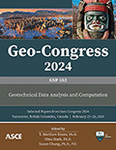Implementation of a Thermomechanical Clay Constitutive Model in Finite Element Analysis Framework
Publication: Geo-Congress 2024
ABSTRACT
Research indicates that heating of soil influences its hydraulic and mechanical response in a coupled manner. While several thermomechanical soil constitutive models are present in the literature, their use in numerical analyses of geotechnical boundary value problems involving thermomechanical loading is rather limited. This paper presents numerical implementation of a thermomechanical soil constitutive model in a finite element analysis (FEA) framework. Building on the basics of the modified cam clay (MCC) model, the discussed constitutive model accounts for thermal influence on soil mechanical behavior through an isotropic hardening mechanism. Upon successful numerical implementation, the constitutive model was calibrated using data from temperature-controlled triaxial compression tests reported in the literature. FE simulations of multiple triaxial tests on different soils and comparison of FEA results with those recorded during laboratory triaxial tests demonstrate successful numerical implementation of the thermomechanical soil constitutive model.
Get full access to this article
View all available purchase options and get full access to this chapter.
REFERENCES
Abaqus. (2014). Analysis user’s manual, version (2014). Providence, RI, USA: Dassault Systemes Simulia Corp.
Abuel-Naga, H. M., Bergado, D. T., and Chaiprakaikeow, S. (2006). Innovative thermal technique for enhancing the performance of prefabricated vertical drain during the preloading process. Geotextiles and Geomembranes, 24(6), 359–370. https://doi.org/10.1016/j.geotexmem.2006.04.003.
Abuel-Naga, H. M., Bergado, D. T., and Lim, B. F. (2007b). Effect of temperature on shear strength and yielding behavior of soft Bangkok clay. Soils and Foundations, 47(3): 423–436. https://doi.org/10.3208/sandf.47.423.
Abuel-Naga, H. M., Bergado, D. T., and Bouazza, A. (2007a). Thermally induced volume change and excess pore water pressure of soft Bangkok clay. Engineering Geology, 89(1-2), 144–154. https://doi.org/10.1016/j.enggeo.2006.10.002.
Abuel-Naga, H. M., Bergado, D. T., Bouazza, A., and Pender, M. (2009). Thermomechanical model for saturated clays. Géotechnique, 59(3), 273–278. https://doi.org/10.1680/geot.2009.59.3.273.
Baldi, G., Hueckel, T., and Pellegrini, R. (1988). Thermal volume changes of the mineral– water system in low-porosity clay soils. Canadian geotechnical journal, 25(4), 807–825. https://doi.org/10.1139/t88-089.
Campanella, R. G., and Mitchell, J. K. (1968). Influence of temperature variations on soil behavior. Journal of Soil Mechanics & Foundations Division, ASCE, 94(3): 609–734. https://doi.org/10.1061/JSFEAQ.0001136.
Cekerevac, C., and Laloui, L. (2004). Experimental study of thermal effects on the mechanical behaviour of a clay. International Journal for Numerical and Analytical Methods in Geomechanics, 28(3): 209–228. https://doi.org/10.1002/nag.332.
Cui, Y. J., Sultan, N., and Delage, P. (2000). A thermomechanical model for saturated clays. Canadian Geotechnical Journal, 37(3), 607–620. https://doi.org/10.1139/t99-111.
Delage, P., Sultan, N., and Cui, Y. J. (2000). On the thermal consolidation of Boom clay. Canadian Geotechnical Journal, 37(2), 343–354. https://doi.org/10.1139/t99-105.
Golchin, A., Vardon, P. J., and Hicks, M. A. (2022). A thermo-mechanical constitutive model for fine-grained soils based on thermodynamics. International Journal of Engineering Science, 174, 103579. https://doi.org/10.1016/j.ijengsci.2021.103579.
Graham, J., Tanaka, N., Crilly, T., and Alfaro, M. (2001). Modified Cam-Clay modelling of temperature effects in clays. Canadian Geotechnical Journal, 38(3): 608–621. https://doi.org/10.1139/t00-125.
Habibagahi, K. (1977). Temperature effect and the concept of effective void ratio. Indian Geotechnical Journal, 7(1), 14–34.
Hueckel, T., and Borsetto, M. (1990). Thermoplasticity of saturated soils and shales: constitutive equations. Journal of Geotechnical Engineering, ASCE, 116(12): 1765–1777. https://doi.org/10.1061/(ASCE)0733-9410(1990)116:12(1765).
Kuntiwattanakul, P., Towhata, I., Ohishi, K., and Seko, I. (1995). Temperature effects on undrained shear characteristics of clay. Soils and Foundations, 35(1): 147–162. https://doi.org/10.3208/sandf1972.35.147.
Laloui, L., and Cekerevac, C. (2003). Thermo-plasticity of clays: an isotropic yield mechanism. Computers and Geotechnics, 30(8), 649–660. https://doi.org/10.1016/j.compgeo.2003.09.001.
Laloui, L., and François, B. (2009). ACMEG-T: soil thermoplasticity model. Journal of Engineering Mechanics, ASCE, 135(9): 932–944. https://doi.org/10.1061/(ASCE)EM.1943-7889.0000011.
Moritz, L. (1995). “Geotechnical properties of clay at elevated temperatures.” Rep. No. 47, Swedish Geotechnical Institute, Linköping.
Plum, R. L., and Esrig, M. I. (1969). Some temperature effects on soil compressibility and pore water pressure. In:, 231-242.
Roscoe, K., and Burland, J. B. (1968). On the generalized stress-strain behaviour of wet clay. In Engineering plasticity, 535–609. Cambridge, UK: Cambridge University Press.
Sloan, S. W. (1987). Substepping schemes for the numerical integration ofelastoplastic stress–strain relations. International Journal of Numerical Methods in Engineering 24 (5): 893–911. https://doi.org/10.1002/nme.1620240505.
Sloan, S. W., Abbo, A. J., and Sheng, D. (2001). Refined explicit integrationof elastoplastic models with automatic error control. Engineering Computation18 (1–2): 121–194. https://doi.org/10.1108/02644400110365842.
Tanaka, N. (1995). Thermal elastic plastic behaviour and modelling of saturated clays. Ph.D. thesis, Univ. of Manitoba, Winnipeg, MB, Canada.
Towhata, I., Kuntiwattanakul, P., Seko, I., and Ohishi, K. (1993). Volume change of clays induced by heating as observed in consolidation tests. soils and foundations, 33(4), 170–183. https://doi.org/10.3208/sandf1972.33.4_170.
Wang, L. Z., Wang, K. J., and Hong, Y. (2016). Modeling temperature-dependent behaviour of soft clay. Journal of Engineering Mechanics, 142(8), 04016054. https://doi.org/10.1061/(ASCE)EM.1943-7889.0001108.
Wang, K., Wang, L., and Hong, Y. (2020). Modelling thermo-elastic–viscoplastic behaviour of marine clay. Acta Geotechnica, 15(9), 2415–2431. https://doi.org/10.1007/s11440-020-00917-9.
Wang, H., Wang, K., Guo, Z., Rui, S., and Wang, Z. (2023). Resistance mechanism of partially embedded pipelines considering the influence of temperature fields. Ocean Engineering, 281, 114720. https://doi.org/10.1016/j.oceaneng.2023.114720.
Wissmann, J. W., and Hauck, C. (1983). Efficient elastic-plastic finite element analysis with higher order stress point algorithms. Computers and Structures 17 (1): 89–95. https://doi.org/10.1016/0045-7949(83)90033-0.
Zhou, C., and Ng, C. W. W. (2015). A thermomechanical model for saturated soil at small and large strains. Canadian Geotechnical Journal, 52(8), pp.1101–1110. doi:https://doi.org/10.1139/cgj-2014-0229.
Information & Authors
Information
Published In
History
Published online: Feb 22, 2024
ASCE Technical Topics:
- Clays
- Constitutive relations
- Engineering fundamentals
- Engineering mechanics
- Finite element method
- Geomechanics
- Geotechnical engineering
- Laboratory tests
- Mathematics
- Methodology (by type)
- Models (by type)
- Numerical methods
- Numerical models
- Soil analysis
- Soil mechanics
- Soil properties
- Soils (by type)
- Tests (by type)
- Thermal analysis
- Thermodynamics
- Triaxial tests
Authors
Metrics & Citations
Metrics
Citations
Download citation
If you have the appropriate software installed, you can download article citation data to the citation manager of your choice. Simply select your manager software from the list below and click Download.
